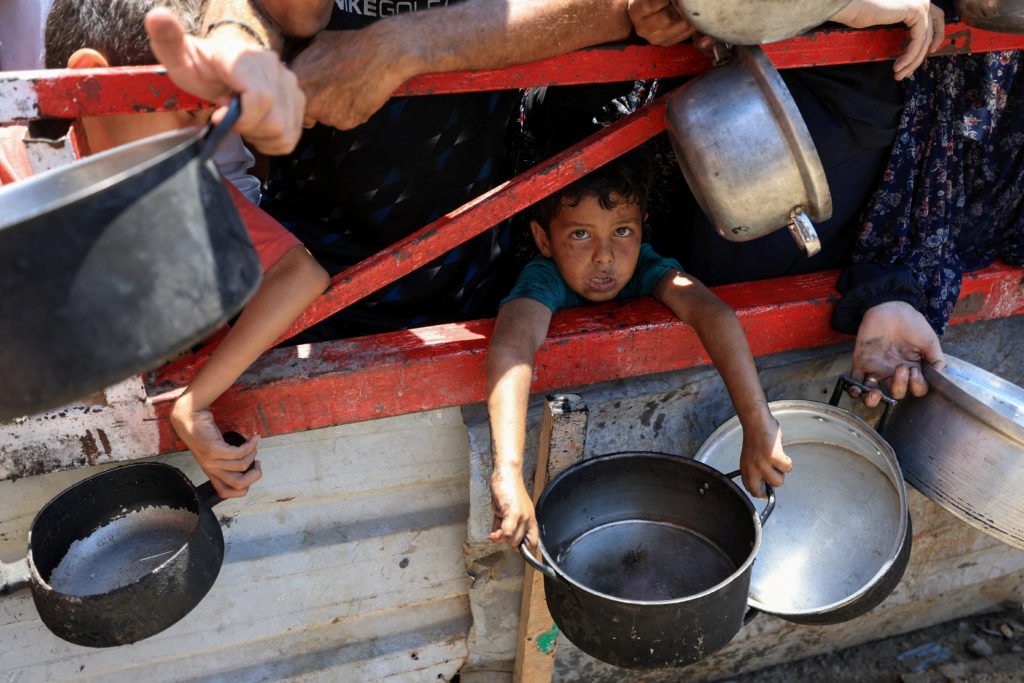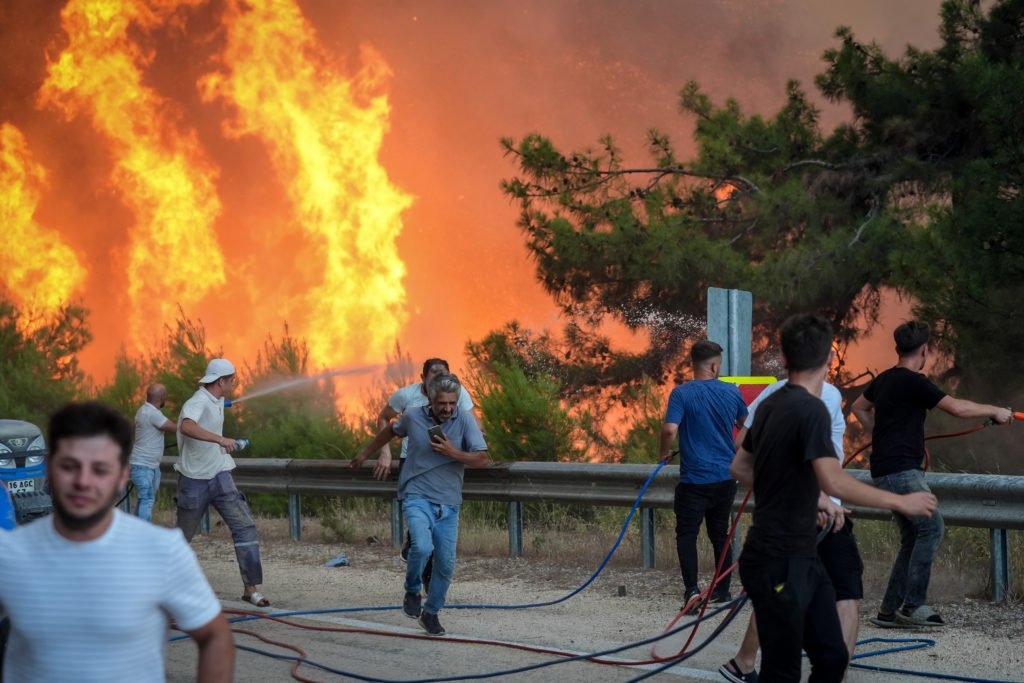This article is republished from the Council on Foreign Relations. Read the original article here.
Hunger is reportedly surging in Gaza as the enclave of nearly two million people remains cut off from aid. U.N. and local health officials attribute hundreds of deaths in recent weeks either to malnutrition or people dying in desperate attempts to procure food from aid distribution points. Locals and humanitarian officials have said the situation is the worst they’ve witnessed since the start of the conflict in October 2023.
International calls are growing for Israel to end the limits on aid distribution, which some experts allege is a violation of international humanitarian law. Israeli, Palestinian, and international actors — including the United States and U.N. organizations — have all been major players in the aid delivery system at various points, though the current aid operation is now limited to one U.S. group with close oversight by Israel.
WATCH: Palestinians describe choice between starvation and risking death to get food aid in Gaza
Misinformation and the lack of outside reporting due to Israel’s media restrictions have made it difficult to develop a clear picture of the situation, experts say. Meanwhile, Israeli officials have defended the controversial, for-profit, U.S.- and Israel-backed Gaza Humanitarian Foundation (GHF). Israeli authorities have said they want an alternative means of delivering aid to Gaza, alleging that Hamas is seizing the aid and using it in part to earn money used to pay its fighters at the expense of the Palestinian population.
U.N. officials have said that staff on the ground and other aid workers, doctors, and journalists are now fainting from hunger and exhaustion due to limited food access — all as the reported death toll from food scarcity incidents continues to grow.
What is going on in Gaza?
Local groups and international aid organizations have highlighted the growing risk to the population in Gaza.
- On July 23, the Palestinian Health Ministry recorded ten more people who have died from starvation over the previous twenty-four hours, bringing the five-day death toll due to hunger to forty-three.
- The U.N. Palestinian agency, UNRWA, has said that one million children in Gaza — half the population — are now at risk of starvation.
- More than fifty children have died of malnutrition since March, according to the World Health Organization (WHO).
- The worsening hunger situation has sent even more people to already overwhelmed hospitals, which the WHO has said are at their “breaking point” — 94% are damaged or completely destroyed due to the conflict.
- The United Nations reported that more than 1,000 Palestinians have died in recent weeks trying to access food. It warned on Tuesday that Gaza’s “last lifelines keeping people alive are collapsing.”
David J. Scheffer, a CFR expert on international law, said the situation could put Israel at risk of war crimes charges, especially if the international community finds that it is obstructing aid or harming civilians seeking it.
“If any strategy of aid obstruction unfolds that leads to starvation among civilians, including willfully impeding relief supplies, then that could risk charges of war crimes,” he said.
Israeli officials have repeatedly rejected allegations that its military actions violate the laws of armed conflict, saying charges have relied on faulty figures provided by Hamas-run health facilities.
The food scarcity has made distribution sites increasingly dangerous. The Palestinian Red Crescent Society said that the Israeli military has “targeted civilians,” accusing them of firing on Palestinians trying to reach aid at a distribution site in northern Gaza. Israel denied the allegation. The Israel Defense Forces said it had “fired warning shots in order to remove an immediate threat” and contested the casualty totals reported.

Palestinians carry aid supplies after trucks loaded with aid entered from Israel through central Gaza, in Gaza City, July 22, 2025. Photo by Khamis Al-Rifi/Reuters
On July 20, nearly 100 civilians were fatally shot as they tried to get food aid from U.N. convoys handing out flour for bread. The week before that, there was a stampede of thousands swarming the GHF aid site, which killed at least twenty people.
How have aid groups in Gaza responded and how are they affected?
More than 100 aid groups operating in Gaza have cautioned that Israel’s aid restrictions are causing a hunger crisis, with Doctors Without Borders stating that “humanitarian organizations are witnessing their own colleagues and partners waste away before their eyes.”
CARE International, a global nonprofit working on hunger and poverty in more than 100 countries, has been operating in Gaza and the West Bank since 1948 and was one of the first organizations to respond to the recent Gaza crisis. What they’re seeing in Gaza now, its Chief Humanitarian Officer Deepmala Mahla told CFR, is “worsening by the minute.” Her team in Gaza has not received an aid shipment in 140 days.
The World Food Program, which also has staff in Gaza, has raised alarm about the situation, saying “nearly one person in three is not eating for days.” Journalists working in Gaza are also affected by the food shortages. French news agency Agence France-Presse (AFP) has reported that its employees in Gaza are starving.
“Since AFP was founded in 1944, we have lost journalists in conflicts, some have been injured, others taken prisoner. But none of us can ever remember seeing colleagues die of hunger,” the outlet’s union said.
What led to this crisis?
Humanitarian aid has long been a contentious aspect of the war between Israel and Hamas since it broke out in 2023. It has frequently been cited as a sticking point in the last few weeks’ ceasefire negotiations.
Steven A. Cook, CFR senior fellow for Middle East Studies, said it has been challenging to track aid over time, as information coming out of the region is difficult to parse and often misleading. The situation is also much more complex than most reports capture, he said.
Aid levels over the war’s twenty-one months have fluctuated, CARE’s Mahla said. But generally, “it has continuously deteriorated,” she told CFR. “Our ability to deliver it has gone down drastically this year.”
In March, Israel halted shipments of aid into Gaza, citing Hamas’s siphoning off the aid for itself, an allegation the group has denied. That ban lasted eleven weeks, until Israel began to allow aid back in by May via GHF. Cook said that Israel pursued this model to keep Hamas from using stolen aid to generate revenue to pay its fighters. But the aid brought in by GHF so far has been a trickle of what was previously provided, both earlier in the war and before the war.
“They were unable to scale it in a way that would actually deliver it in an effective and safe way,” Cook explained. “It clearly has not worked and has cost many people’s lives.”
What have the Israeli, Hamas and international roles been?
The United States has supported the GHF with at least $30 million in June — though tranches of the money won’t be released until the GHF completes certain tasks, including pre-vetting partners. With the Donald Trump administration’s distrust of the United Nations, Cook said, the alternative aid channel was more appealing since it was not affiliated with the international body, but instead with its ally, Israel.
Hamas and Israel are both provocateurs in the melee of aid chaos, Cook said. Hamas has incited violence at aid sites to create chaos, he said, knowing that the Israelis will be blamed for the chaos in Gaza. Israel’s motivations for constricting aid are both to keep it out of the hands of Hamas and as a means of wielding political control to “demoralize the population,” said Cook.
Hamas has insisted that aid is funneled solely through the United Nations, which raises concerns among some experts that Hamas has been able to take advantage of the U.N. system.
“The malnutrition that’s happening is clearly a function of the fact that the Israelis withheld aid for eleven weeks and then moved into this mode of the GHF,” Cook said. But “the distribution of aid was hardly easy when it was being run by U.N. aid agencies.”

Displaced Palestinian mother Samah Matar holds her malnourished son Youssef, who suffers from cerebral palsy, at a school where they shelter amid a hunger crisis, in Gaza City, July 24, 2025. Photo by Mahmoud Issa/Reuters
What’s next for Gaza?
Humanitarian watchdogs are calling for the immediate reduction of bureaucratic barriers to bringing aid in and stopping the targeting of aid workers.
A group of twenty-eight foreign ministers including Canada, Japan, and the United Kingdom condemned the recent deaths at food aid sites in a statement on Tuesday and said that the war “must end now.” U.S. Middle East envoy Steve Witkoff on Thursday announced his team was cutting short its latest efforts to broker a ceasefire and hostage deal, saying Hamas “shows a lack of desire.” He said in a statement, “We will now consider alternative options to bring the hostages home and try to create a more stable environment for the people of Gaza.”
In the absence of a ceasefire, “The rules of engagement for military troops should prioritize the lives of innocent civilians seeking humanitarian relief under desperate wartime conditions threatening their very survival,” Scheffer said.
But Cook adds that “there’s been no indication to me that the White House, the State Department, anybody, has really leaned on the Israelis to allow the United Nations to distribute aid. We’ve been hobbled by our own politics over the United Nations.”
Will Merrow created the graphic for this article.




